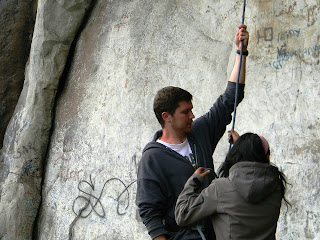 |
| After Bogota, you will be begging for Los Angeles traffic. |
Dictionary.com defines chaos as:
-a state of utter confusion or disorder; a total lack of organization or order
If you ever came to Bogotá, after spending two minutes on the street, you would agree that the above definition offers an adequate description of Bogotá’s transportation system. After five minutes, you would realize calling it mere chaos is a gross understatement—it’s more like pandemonium.
But you’ve got places to be, so you need to figure out how the heck are you going to get there.
Here are your options:
 |
| Pandemonium. |
Taxi Cab
Every traveler’s natural first choice, you hail a cab and tell them in broken Spanish to take you where you need to go. God forbid you are over six feet tall—most of Bogotá’s taxis seem to be designed to carry the cast of Little People, Big World and not your typical gringo. Nevertheless, learning how to squish into uncomfortably compact spaces is a skill that will serve you will during your time in this city.
The taxi pulls away from the curb and you enter the automotive fray. At first, everything seems to go okay—other than the occasional bump on the uneven road, you could even say you are having a good time. But your satisfaction is short-lived as you see an elderly woman ambling across the road ahead. You are no physicist, but you can clearly see that the old woman’s current velocity isn’t great enough to escape the taxi’s warpath. Rather than slowing for the passing pedestrian, the taxi driver honks and accelerates towards the hapless grandma. You close your eyes and cringe as you await the inevitable—but at the last possible moment, the driver swerves, narrowly sparing the grandma’s life. Nearly to your destination, you see a four-way stop ahead. The driver sluggishly looks both ways and flies through the stop sign, treating it more like a yield sign.
 |
| In Bogota, Stop Signs equals Yield (if you're lucky). |
When you finally arrive, you realize the taxi meter is not even on. The driver tells you an arbitrary amount, likely tacking on a gringo tax of a mil or two. But that’s okay—at this point, money is no longer an object—you are grateful to be alive.
 |
| Usually the colectivos don't look this nice. |
Colectivos
You don’t have a lot of pesos to throw around, so you decide to take one of the shady-looking colectivo buses that stampede like mastodons through a herd of mini cabs and motorcycles. You wait near what appears to be a bus stop, but find that none of the colectivos are actually stopping there. After a few minutes of awkward loitering, a Bogotano comes up next to you and sticks out their hand, as if they intend to hitchhike. Dumbfounded as to why someone would try to hitchhike inside a sprawling city—much less at a bus stop—you smirk and shake your head. The Bogotano continues to stick out their hand and—as if by magic—the next colectivo comes to an abrupt halt next to him. The person gets on and the bus disappears down the road.
 |
| Colectivos in action. |
Intrigued, you decide to mimic the hitchhiking maneuver and—lo and behold—the next colectivo stops for you. You barely have both feet inside the vehicle when the bus rockets off down the road, causing you to knock your head on a low-hanging safety bar. After you pay the driver the required $1400 pesos, you are disappointed to see that all the seats are occupied. Reluctantly, you grab one of the support bars and hold on for dear life as the colectivo driver brings the vehicle to an ungraceful spasm of a stop, quickly followed by a rapid acceleration. Since you are too tall for the vehicle, you are forced to turn your head to the side, straining your neck every time the collectivo driver slams on the brakes to let someone off. So many people file onto the bus that you can no longer see out the windows. When you think you are where you wanted to go, you press a red button near the back door, which signals the driver to stop. Barely out the door, the bus speeds off down the street as if an imaginary Tyrannosaurus Rex were chasing it.
 |
| A TransMilenio stop at rush hour. |
TransMilenio
With the taxi option being too expensive and the colectivo looking too much like a deathtrap on wheels, you decide to try your luck with Bogotá’s mass transit system—TransMilenio. You purchase a pass for $1700 pesos, enter one of the platforms and are instantly reminded of a subway—except that it is above ground and utilizes large, red buses. You find one of the system maps and carefully study it to find out which bus you need to take.
 |
| Inside TransMilenio |
Once you figure it out, you head over to the area where your bus will arrive. Unfortunately, you made the noob mistake of using TransMilenio during rush hour and when the first bus pulls up, you find it to be as stuffed as the empanada you ate for lunch. With no hope of forcing your way onto the crowded bus, you are forced to wait for the next one, which arrives a few minutes later. Although this bus is also comically crammed, you see a small opening and go for it—barely making it in before the doors closes on your arm.
Impossibly jammed inside a jungle of intermixed human limbs, the bus speeds down the express lane to the next station—you now know what it feels like to be a sardine on a rocket ship.










































